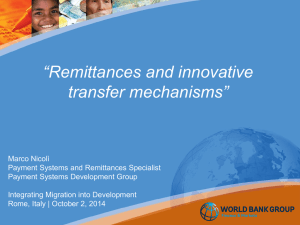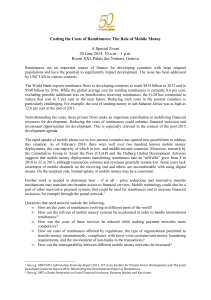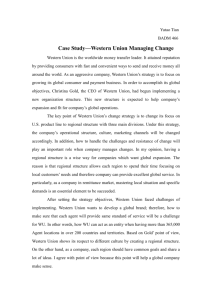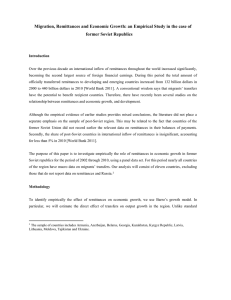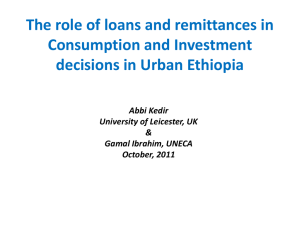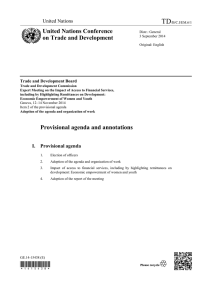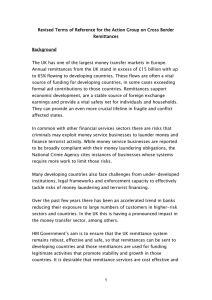M H R
advertisement
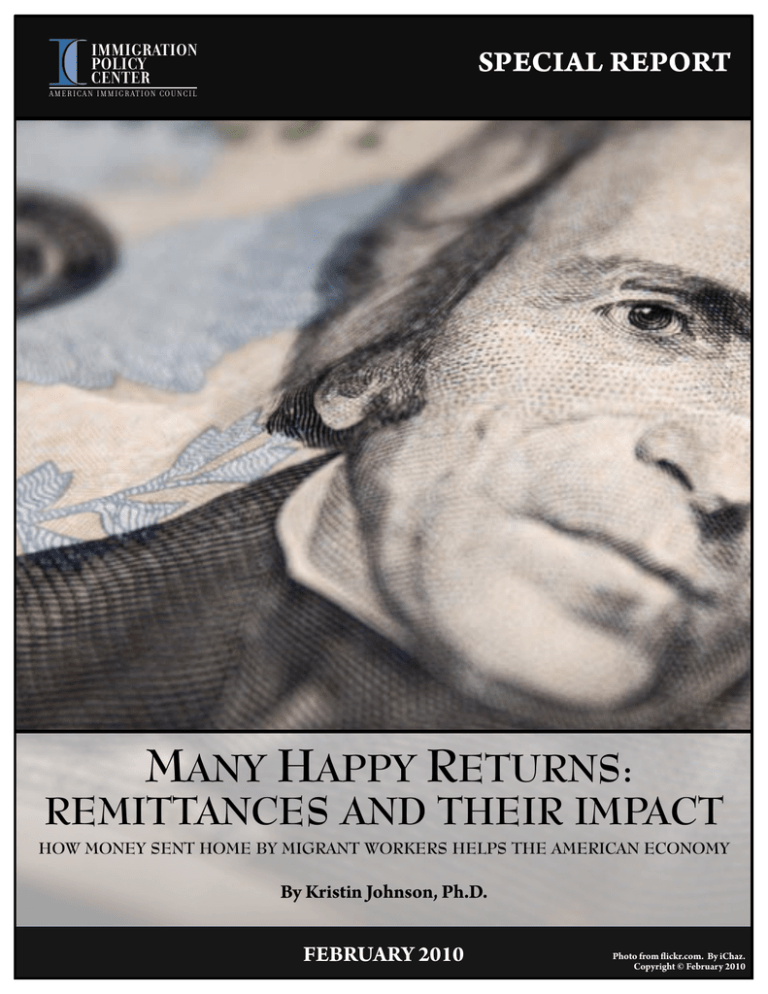
IMMIGRATION POLICY CENTER SPECIAL REPORT A M E R I C A N I M M I G R AT I O N CO U N C I L MANY HAPPY RETURNS: REMITTANCES AND THEIR IMPACT HOW MONEY SENT HOME BY MIGRANT WORKERS HELPS THE AMERICAN ECONOMY By Kristin Johnson, Ph.D. FEBRUARY 2010 Photo from �ickr.com. By iChaz. Copyright © February 2010 MANY HAPPY RETURNS: REMITTANCES AND THEIR IMPACT HOW MONEY SENT HOME BY MIGRANT WORKERS HELPS THE AMERICAN ECONOMY FEBRUARY 2010 KRISTIN JOHNSON, PH.D. ABOUT SPECIAL REPORTS ON IMMIGRATION The Immigration Policy Center’s Special Reports are our most in‐depth publication, providing detailed analyses of special topics in U.S. immigration policy. ABOUT THE AUTHOR Kristin Johnson, Ph.D., joined the Political Science Department at the University of Rhode Island as an Assistant Professor in the Fall of 2007. She received her Ph.D. from Claremont Graduate University in 2007. Her current research interests include the relationship between state capabilities and internal conflict, and resource distribution and development. She is the former Co‐Editor of International Interactions and a member of the TransPacific Consortium. At URI, Kristin teaches courses in International Political Economy, Comparative Politics, and Civil Conflict. ABOUT THE IMMIGRATION POLICY CENTER The Immigration Policy Center, established in 2003, is the policy arm of the American Immigration Council. IPC's mission is to shape a rational national conversation on immigration and immigrant integration. Through its research and analysis, IPC provides policymakers, the media, and the general public with accurate information about the role of immigrants and immigration policy on U.S. society. IPC reports and materials are widely disseminated and relied upon by press and policymakers. IPC staff regularly serves as experts to leaders on Capitol Hill, opinion‐makers, and the media. IPC is a non‐partisan organization that neither supports nor opposes any political party or candidate for office. Visit our website at www.immigrationpolicy.org and our blog at www.immigrationimpact.com. Supported in part by a grant from the Foundation to Promote Open Society TABLE OF CONTENTS INTRODUCTION............................................................................................................................... 4 Remittances Allow Immigrant‐sending Countries to Spend More on U.S. Exports...................................... 5 States with Large Numbers of Immigrants Export More to Foreign Countries ............................................ 8 Remittances Build Financial Infrastructure, Benefiting U.S. Export Based & Financial Companies ........... 10 Remittances Contribute to Economic Stability in Developing Countries.................................................... 11 Remittances Do Not Contribute to Economic Downturns in the United States......................................... 12 Remittances Revisited................................................................................................................................. 13 3 INTRODUCTION Each year, immigrants all over the world send, or remit, a portion of their income to their family members living in their home countries. The amount of remittances has increased exponentially over the last decade which indicates that remittances are becoming the largest source of resource transfers from developed to developing countries. The World Bank estimated that in 2008, worldwide remittances exceeded $397 billion dollars. 1 Remittances from the U.S. comprise between one quarter and one half of the global total, with conservative estimates placing the value around $100 billion dollars. 2 We most often think of Mexico, but remittances are important to many countries. Remittances account for nearly a third of national incomes in countries like Tajikistan and Laos, a fifth in El Salvador and Honduras, and nearly 12% in the Philippines. 3 The growing consensus on remittances is that they are critical resources for individuals in developing countries. Recipients of remittances are often the most impoverished sectors of the population in developing countries. Remittances increase the capacity of poor individuals to consume more goods; facilitate the development of financial infrastructure; and provide otherwise unavailable micro financing for individuals to start small businesses. The impact of remittance outflows on countries is less explored. Too often, remittances are viewed negatively because people assume that money sent abroad is bad for the U.S., primarily because the money is not spent within the United States. Concerns regarding remittance flows are often highlighted in recessions and periods of economic challenge because domestic consumer spending is seen as the solution to economic contraction. Superficially, this makes sense; income sent and spent abroad does not stimulate economic growth through consumption in domestic markets. However, this view of resource flowing in an increasingly globalized world does not accurately depict the financial consequences of remittances on the country of origin. Careful examination of the evidence demonstrates that during periods of economic downturn, when domestic consumption is critical, individuals choose to decrease the amounts they remit, instead spending money on domestic purchases and businesses in the United States. Furthermore, remittance outflows likely provide long term benefits to the U.S. economy. Remittances boost the consumption of U.S. exports, resulting in expansion of U.S. business and trade competitiveness. Ultimately, sending money abroad expands the consumer base able to purchase U.S. goods, a critical facet in maintaining a strong U.S. economy. 4 Remittances Allow Immigrant‐sending Countries to Spend More on U.S. Exports Accounts of how remittances are spent vary substantially across existing studies and literature. The general consensus is that remittances increase consumption in domestic markets, whether on necessary consumer goods, luxury items, or even investment in non‐publically funded education or the creation of small businesses. Asia receives the largest total sum of remittances, although Latin America and the Caribbean remain large recipients as well. Global Remittance Totals Ea s t As i a a nd Pa ci fi c Europe a nd Centra l As i a La ti n Ameri ca a nd Ca ri bbea n Mi ddl e‐Ea s t a nd North Afri ca South As i a Sub‐Sa ha ra n Afri ca 6% 24% 22% 17% 20% 11% Data are from World Bank Staff estimates based on the International Monetary Fund Balance of Payment Statistics for 2008 Regardless of how they are spent, remittances represent an increase in the resources available to households, allowing the poorest parts of the population to increase their spending on consumer or other goods. Remittances allow households to purchase goods they would otherwise need to produce, increasing the market for even basic household goods and increasing the available labor supply as individuals are able to focus on outside employment rather than household production. Mexico provides a good case study. Remittances to Mexico reached their peak in 2006, at nearly $6.2 billion dollars, and in 2007, Mexico was one of the top three global remittance recipients. 4 Remittances constitute 2‐3% of Mexico’s GNP, and represent one of the largest inflows of foreign capital into the country. 5 Studies of remittance inflows in Mexico show that remittances have the largest economic impact in poorer southern Mexican states. Up to 80% of funds received in those states go to household expenses such as food, clothing and other goods. 6 In order to facilitate economic development efforts, the Mexican government has facilitated the use of remittance funds in micro enterprise efforts, resulting in investment in small business enterprises by Mexican remittance recipients. For the poorest 10% of the population, remittances make a key difference in purchasing capabilities. 5 Economists call family spending on individual consumer goods and services—including rent, food and clothing purchases, recreational activities, and transportation services—household consumption expenditure. The poorest 30% in Mexico, largely due to remittances, are approaching nationally average levels and spending 23% of household expenditures on food and 5% of household expenditures on clothing. 7 This indicates that the poorest sectors of the population are shifting from subsistence to purchasing household goods. The increase in purchasing increases the demand for goods and services which, in turn, increases the portion of the population that actively participates as market consumers. With an increase in poorer sectors of the population participating in market activity and consumption, demand for goods and services increases. The chart below indicates national per capita averages of household consumption expenditure in Mexico from 2000‐2009. Mexico: Household Consumption Expenditure 2000‐2009* $3,922 2009 $4,378 $4,749 $4,602 $4,408 $4,183 $3,969 $3,886 $3,742 $3,560 Year 2007 2005 2003 2001 $0 $1,000 $2,000 $3,000 $4,000 $5,000 Consumption Expenditure *Data are from the World Development Indicators. Household Consumption Expenditure is per capita and reported in 2000 Constant Dollars Increases in per capita spending on individual resident household goods and services correspond closely to the pattern of remittance flows, with remittance levels increasing until 2007 and declining in 2008‐2009. This is good for U.S. exports. Increases in household revenues increase the demand for goods and the ability to purchase imported goods. Export increases from three states that comprise over half of U.S. trade with Mexico also increased substantially from 2005‐2008; Texas realized $50 million in exports to Mexico in 2005 which rose to $62 million in 2008, with an increase of 10.9% from 2007 to 2008 alone. With even larger increases albeit smaller total exports, Arizona increased exports from $4.7 million in 2005 to $5.9 million in 2007 and a 12.9% increase from 2007‐2008, and California increases exports from $17.2 million in 2005 to $20.4 million in 2008, and an increase of 14% between 2007 and 2008. 8 6 Mexico is an increasingly important market for U.S. exports. Increases in Mexico’s ability to purchase consumer goods increases the demand for goods produced in the United States, both as consumer purchases (for example clothing, electronics, and other items) and in building business and financial infrastructure that accompanies economic expansion. Individuals with increasing income may wish to purchase a broader variety of goods that are cheaper to import due to the technological requirements of production. Exports from developed countries often consist of manufactured or high tech or luxury goods that entail high startup costs for domestic producers. For example, civilian aircraft, engines and parts and electronic integrated circuitry comprise some of the highest value in exports, comprising over 10% of total export value in California and Arizona. In Texas, oil and machinery to support oil extraction are the highest value exports. Remittances are inflows of foreign capital that can increase human and physical capital accumulation in developing countries. In other words, remittances allow the current and future work force to acquire additional education and training. Thanks to remittances, children can stay in school longer instead of having to work, and families can invest more in skill development and training. Families are also able to save money and make purchases that increase their productivity, with investments ranging from tractors and mechanized production to computers and technological assets becoming accessible for an expanding population. These increases in spending can often increase demand for non‐tradable goods, such as water and electricity, or goods that are not easily imported. In developing countries, remittances are most often received by low and middle income people. These individuals are the most likely to increase their consumption in household items, transportation, communication and non‐ tradable goods. Large increases in non‐tradable good demand can increase prices, as larger segments of the population either gain access to or increase their use of non‐tradable goods. This increase in prices creates upward pressure on the local currency and increases real exchange rates. This has the effect of increasing the competitiveness of foreign goods and increasing their consumption. Given that Mexico is a critical market for U.S. exports, this is great news for U.S. manufacturers. Remittances may also change the type of consumption taking place. High income earners in developing markets already have access to non‐tradable goods. However, increases in income do increase the demand for status or luxury items, including everything from processed food items to expensive jewelry. In other words, remittances make middle class consumption practices practical for populations that are otherwise precluded from these spending opportunities. By exposing migrant populations to a new culture and new things, migration is accompanied by an increased demand for trendy or cultural goods. This is evident in everything from diversification of food items in U.S. grocery stores to the presence of U.S. clothing, grocery items, and food franchises in other countries. Mexico is a major market for U.S. snack foods and the largest export market for U.S. textiles, which alone account for over $3 billion in exports. 9 Remittances, in conjunction with exposure to foreign goods, increase import 7 consumption. Between 2004 and 2008, alcohol exports from the U.S. to Mexico increased in value 334%, and exports of sporting goods, toys and games increased in value 492%. 10 Markets for U.S. goods are created by familiarity with the goods accompanied by purchasing power. States with Large Numbers of Immigrants Export More to Foreign Countries The following chart illustrates exports by share by state. California, New York, Texas and Florida account for 36.6% of total U.S. export share alone. Percent of US Total Exports 2.1% Ca l i forni a 4.2% 11.2% 2.2% 1.5% New York Texa s Fl ori da 2.8% Il l i noi s New Jers ey 6.3% 4.2% Ari zona Ma s s a chus etts 4.2% Georgi a 14.9% Wa s hi ngton *Data are from The U.S. Census Bureau Financial Trade Division and reflect 2008 values. Note that not all states are included – but the 15 states that are comprise over 53% of U.S. total exports. The states listed above are the 15 with the largest foreign born resident populations, according to the U.S. Census Bureau Statistics Division. These 15 states account for over 53% of total national exports. Some of the largest foreign born populations in the United States come from Mexico, China, the Philippines, and India. The following table supports the assertion that cultural transfer between immigrant and residents in respective countries results in increased demand for goods and products manufactured in the United States. States with large Mexican born populations such as California, Texas, and Arizona, are also characterized by a high percentage of state exports going to Mexico at 14.1%, 29.9% and 32.3% respectively. Exports to Mexico, China, the Philippines, and India constitute nearly 15% of exports among states with large foreign born populations from these countries. 8 This table is only a snapshot illustrating state export totals. Table 1: Percentage of State Exports to Selected Foreign Countries Percent of Percent of State Exports to: States Total State Mexico China Philippines India Exports California 14.1% 7.6% 0.9% 1.6% 24.2% New York 2.9% 3.5% 2.3% 8.7% Texas 32.3% 4.4% 1.0% 37.7% Florida 4.6% 1.6% 4.3% 10.5% Illinois 7.9% 4.7% 1.7% 14.3% New Jersey 4.1% 2.8% 6.9% Arizona 29.9% 6.3% 0.9% 37.1% Massachusetts 4.1% 5.5% 1.5% 1.4% 12.5% Georgia 5.9% 7.3% 1.1% 14.3% Washington 1.6% 15.2% 1.3% 2.5% 20.6% Virginia 3.6% 6.1% 9.7% Maryland 3.6% 5.0% 1.7% 10.3% Pennsylvania 7.0% 4.7% 1.2% 12.9% North Carolina 7.1% 7.7% 0.8% 15.6% Michigan 14.2% 1.9% 16.1% These data suggest some interesting interpretations. States with large foreign born populations are likely to be those that have significant labor or job opportunities for emigrating individuals. These same states, however, make up the largest export share of the United States. Likely explanations include the idea that migrant labor decreases production cost making goods more competitive; that migrant populations transmit cultural exposure to goods and services creating demand for imports from the United States; or most likely, that remittances increase domestic consumption and increase exposure to U.S. goods. In addition, migrant populations are often not permanent emigrants, relocating to the United States to work and returning to their country of origin either following a labor demand cycle that may be seasonal (agriculture and construction) or after income earning goals are realized. The result is temporary employment creating a permanent demand for subsets of U.S. goods. Asia and Latin America comprise receive the largest annual global remittance contributions. In 2008, 46% of remittances flows went to Asia (excluding central Asia) and 20% of remittances flows went to Latin America and the Caribbean. 11 Exports to Asia and Latin America by the 15 states with largest foreign born populations totaled over $692 million in 2008. 9 In summary, remittances are a long term investment in the U.S. export economy. Available evidence indicates that in poorer countries, remittances prompt consumer spending, increasing export competiveness for U.S. goods. Remittances are also used to fund education and health services, increasing human capital and ultimately the earning potential of individuals in a country. U.S. exports of technological, recreational, or luxury goods become feasible as incomes increase and the expectation of economic security and gains increases for populations. Remittances create the ability and desire to purchase U.S. goods, creating new markets for these goods, and increasing global trade competitiveness for U.S. industries. Remittances Build Financial Infrastructure, Benefiting U.S. Export Based & Financial Companies Perhaps the most overlooked advantage of remittances to developed countries is the creation of financial infrastructure in developing markets. The World Bank’s International Finance Corporation (IFC) currently tracks transaction costs for remittances across the 134 most active remittance corridors, or most common remittance flows. Through partnerships with non‐ governmental organizations, regional networks, and banks, the IFC intends to facilitate internet access and increased financial infrastructure including access to electronic banking and banking resources generally, and education and training in financial transfer to populations lacking this access. A second goal of this effort is to increase transparency in remittance fees, making electronic transfer more attractive for those choosing to remit. Remittance fees are often quite varied, including fees for exchange rates and other services. For example, the fee assessed by Bank of America for remitting $200 to China is $56.52, over 25% of the value of the remitted sum. Western Union charges $14.82 for the same transaction. 12 Companies with partners or a presence in foreign markets often have lower fees associated with remitting, as their costs are lower and they are able to lower fees while maintaining profits. As a result, companies such as the Hong Kong and Shanghai Banking Corporation (HSBC) are able to reduce the fee to remit substantially; HSBC charges a $2 fee for remitting $200 to India. 13 The new World Bank remittance efforts encourage partnerships between banks in developed countries and those in developing countries who are large remittance recipients. Banks realize a substantial return for increasing their involvement in electronic financial transfers, or in other words, electronic remittances increase banking profits. As legislation and regulation in financial transactions have increased, the percentage of remittance transactions taking place electronically has increased substantially. This has several immediate financial repercussions. First, those choosing to remit may accept significant fees in order to have a monitored and quick transaction. Sending cash requires resources to exchange currency, increases the risk of theft or loss, and takes substantial periods of time. The majority of remittances are made in 10 small disbursements, several hundred dollars at a time. Individuals choosing to remit increasingly opt to accept the cost of electronic transfer over cash transactions in order to increase speed, security, and convenience. Remittances represent a new and quickly growing part of the financial sector. The United States is a leader in financial services. Increasing electronic remittances, supporting the extension of financial markets, and increasing the volume of electronic transfers broadens market opportunities and increases the opportunity for U.S. companies to fill new niche markets. Because remittances are concentrated in regions of countries that are incredibly poor, companies expanding into these markets and providing financial services are gaining customers that are new to financial services and banking. The opportunity to secure market access for these services gives companies huge profit opportunities, with global remittances estimated at over $500 billion, the profit potential for the electronic transfers of these funds is huge. There is little risk to U.S. banks who partner with domestic providers, and those who make transfers at attractive rates are likely to substantially increase their domestic customers. Already, companies like Western Union and Bank of America are increasing international presence and international partnerships in financial services. As this infrastructure and ease of access expands, use will be increasingly frequent, decreasing transaction costs and encouraging additional individuals to choose this route to remit. This increases business and tax revenues for U.S. companies and states as well as supporting emerging financial systems in developing countries. Remittances are funds that have been largely regarded as disappearing from domestic consumption. The new focus on electronic transfers brings them back into the formal economy, resulting in net gains for financial transfer companies and taxable assets. An ancillary benefit includes the creation of familiar financial infrastructure, facilitating investment and fiscal transparency, both important to establishing stable economies and increasing the ability to trade. Remittances Contribute to Economic Stability in Developing Countries Remittance inflows can increase economic stability by increasing foreign reserves through exchange of monies. Remittances sent in dollars typically require exchange into domestic currencies. Banks are able to increase their foreign reserves through this process of exchange, and maintain demand for the national currency. Foreign reserves allow countries to stabilize their currencies to a greater degree during periods of crisis. Governments that do face challenges caused by high remittance inflows, such as in Tajikistan, are forced to increase their fiscal infrastructure in order to effectively regulate the large inflows of capital, resulting in strong macro economic policies and planning. Countries like Mexico have taken a more 11 proactive approach, encouraging the use of remittance revenues in micro enterprise efforts as part of an effort to directly integrate remittances into their development strategies. Economic stability, economic planning and fiscal transparency resulting from remittance inflows are good for U.S. companies and investors; each of these approaches creates investment climates that increase the financial stability of assets and markets in these countries. Remittances Do Not Contribute to Economic Downturns in the United States A common misconception surrounding remittances, extrapolated in part from the minor economic downturn of 2000‐2001, is that remittance levels remain constant despite the economic performance. 14 Evidence from increasingly accurate data strongly indicates that remittances substantially contract when the economy goes sour. Research jointly conducted by USAID and the Department for International Development includes estimates that in 2009, 40% of unemployed workers will choose not to remit. 15 Of those remaining employed, 25% are anticipated to decrease their remittance contributions by 10%. 16 The same publication estimates a decline of 7% in global remittances in 2009. This relationship holds globally. Encompassing one of the largest global remittance corridors, outflows from the United States to Mexico often receive substantial negative attention due to the large number of Mexican workers employed in both the formal and informal sectors in the United States. 17 The chart below indicates quarterly changes in remittance inflows to Mexico from the United States. Immediately clear is the contraction in remittance inflows in all quarters of 2008 and the first two quarters of 2009. Percent Change in Remittance Totals Mexico Remittance Inflows by Quarter: 2006 – 2009* 2006 2007 2008 *Data from the Banco de Mexico 18 12 2009 The above chart indicates a ‐6.3% average per quarter decline in remittance inflows from 2008 through the first two quarters of 2009. These declines exceed estimates for total global remittance decreases, with remittance declines in the first two quarters of 2009 averaging at ‐ 8% from the previous quarter. Note that these are not cumulative decline numbers but reflect an ongoing progression of decline. At the current rate of remittance decreases, remittance inflows to Mexico will decrease by 9.6% in 2009. Remittances Revisited While remittances are often viewed negatively as money leaving the U.S., remittances represent the beginning of a chain of economic interactions beneficial to the U.S. economy, rather than a net loss. Remittances dramatically increase the pool of possible foreign consumers for U.S. goods; individuals are given the means to purchase U.S. exports and exposed to U.S. goods through emigrants. In the long term, remittances just may be a major contributing factor in U.S. export goods remaining competitive and finding new markets. Remittances comprise a win for both the domestic market and U.S. exporters. Another immediate benefit of remittances is the increase in the profits of financial companies and banks, through increasing reliance on electronic transfers of funds. Remittances also contribute to the stability of foreign economies, decreasing the exposure of U.S. investors and companies, resulting in higher profits for investors and lowering the cost of doing business for companies. During periods of economic downturn, when domestic consumption is critical, individuals choose to decrease the amounts they remit, instead spending money on domestic purchases and businesses in the United States. In periods of economic prosperity, remittances boost the consumption of U.S. exports, resulting in expansion of U.S. business and trade competitiveness. Ultimately, remittances yield surprising benefits to the U.S. economy, primarily in sectors where it is most needed. Endnotes 1 Dilip Ratha, Sanket Mohapatra, and Ani Silwal (2009) Outlook for Remittance Flows 2009‐2010. Migration and Development Brief 10. The World Bank Group: Washington DC. July. Available at: http://siteresources.worldbank.org/INTPROSPECTS/Resources/MD_Brief9_Mar2009.pdf. 2 Ibid 3 International Monetary Fund (2009). International Financial Statistics. Washington DC. http://www.imfstatistics.org/imf/ 4 Dilip Ratha, Sanket Mohapatra, K. M. Vijayalakshmi, Zhimei Xu (2007). Remittance Trends 2007. Migration & Development Brief 3. The World Bank Group: Washington DC. November 29. Available at: http://siteresources.worldbank.org/EXTDECPROSPECTS/Resources/476882‐1157133580628/BriefingNote3.pdf 5 Workers Remittances by State. (2009). Banco de Mexico Financial Statistics. http://www.banxico.org.mx/SieInternet/consultarDirectorioInternetAction.do?accion=consultarCuadro&idCuadro=CE100&loca le=en 6 Federal Reserve Bank of Dallas (2004). Worker’s Remittances to Mexico (2004). Business Frontier: El Paso Branch. Issue 1. http://www.dallasfed.org/research/busfront/bus0401.html 7 International Labour Office (2009). ILO Yearbook of Labour Statistics ILO LABORSTA http://laborsta.ilo.org/ 13 8 US Census Bureau. (2009) US Census Bureau Foreign Trade Division Statistics. http://www.census.gov/foreign‐ trade/index.html 9 Ibid. 10 US Census Bureau. (2009) US Census Bureau Foreign Trade Division Statistics. http://www.census.gov/foreign‐ trade/index.html 11 International Monetary Fund (2009). International Financial Statistics. Washington DC. http://www.imfstatistics.org/imf/ 12 Ibid. 13 Ibid. 14 Remittances decrease following economic crisis in developing countries, as increasingly difficult economic circumstances motivate increasing migration to developed countries and consequently larger remitting populations. 15 Dilip Ratha, Sanket Mohapatra, and Ani Silwal (2009) Outlook for Remittance Flows 2009‐201. Migration and Development Brief 10. The World Bank Group: Washington DC. July. Available at: http://siteresources.worldbank.org/INTPROSPECTS/Resources/MD_Brief9_Mar2009.pdf. 16 Ibid. 17 InterAmerican Development Bank (2008). Remittances to Latin America and the Caribbean. http://www.iadb.org/mif/remesas_map.cfm?language=English&parid=5 18 Data are available from www.banxico.org.mx These data are unique in their ability to capture both formal and informal remittance flows. Unlike estimates from the often cited US Department of Commerce (USDC), the Bank of Central Mexico has formalized its remittance accounting procedures. In October of 2002, new Central Bank rules stipulated money transfer and bank registration and quarterly reporting of electronic monetary transactions to Mexico’s central bank. Quarterly data, published by state designation, are supplemented by estimations of non electronic remittance flows through annual surveys conducted at border crossings. Mexico’s remittance estimates are generally higher than those reported by the USDC, but correspond much more accurately to household surveys of remittance and consumption. This represents the best available data that is biased toward over rather than under estimation of remittance totals. 14
